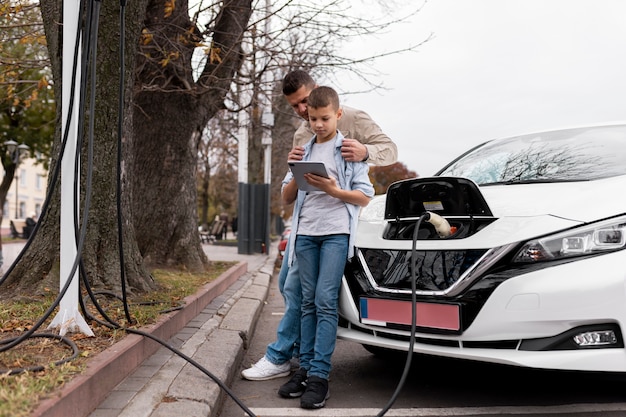A Guide to Alternative Fuel Vehicles
Introduction
Are you tired of dealing with all the hassles of owning a conventional vehicle, like high gas prices and automobile emissions? If so, consider switching to one of the many alternative fuel vehicles on the market today. Not only will you reduce your carbon footprint, but you’ll also save money in the long run! In this article we’ll discuss each type of alternative fuel vehicle and how it works.
Natural Gas
Natural gas is a fossil fuel, but it’s cleaner than gasoline or diesel. Natural gas is made up of methane, which is a powerful greenhouse gas–and the main ingredient of natural gas. It takes more energy to extract and transport natural gas than it does for other fuels like coal or oil, so using it for transportation has its drawbacks as well (for example: extracting and transporting natural gas requires a lot of drilling).
Natural gas vehicles are still in the early stages of development; there aren’t many models available yet, and they’re expensive compared with traditional cars powered by gasoline or diesel engines. But if you want to reduce emissions from your car without sacrificing performance or comfortability then this might be worth exploring!
Hydrogen
Hydrogen fuel is an alternative to gasoline. It’s a clean, efficient and renewable energy source that can be used in a variety of vehicles. Hydrogen fuel is safe, with no risk of explosion or fire like you might see in other types of alternative fuels such as ethanol or natural gas.
Hydrogen fuel also has some notable advantages over traditional gasoline: it’s lighter than air so it doesn’t require special storage tanks; its molecules are small enough not to clog filters; it can be produced from any source (including water); once produced it doesn’t require any additional refining process like other liquid fuels do; and finally because hydrogen produces only water when combusted there are no harmful emissions released into the atmosphere during operation!
Electricity
Electric vehicles are much more efficient than internal combustion vehicles, and they can go much further on a single charge. Electric motors use far less energy to move the same distance, which means that you’ll get better gas mileage on an EV than you would in an ICE vehicle. They also have fewer moving parts–which means they require less maintenance and have fewer breakdowns–and produce fewer emissions than internal combustion engines do.
Ethanol (E85)
Ethanol, or E85, is an alternative fuel that can be used in flex-fuel vehicles. It’s a mixture of 85{a5ecc776959f091c949c169bc862f9277bcf9d85da7cccd96cab34960af80885} ethanol and 15{a5ecc776959f091c949c169bc862f9277bcf9d85da7cccd96cab34960af80885} gasoline–a higher concentration than regular gas and diesel but lower than hydrogen.
E85 has some advantages over traditional fuels: it burns cleaner than gasoline and diesel, and it produces less carbon monoxide (which can cause health problems). It also costs less per gallon than regular unleaded or premium fuel because it reduces greenhouse gases by about 30{a5ecc776959f091c949c169bc862f9277bcf9d85da7cccd96cab34960af80885} compared to petroleum-based fuels.[1] The main disadvantage of using E85 is that it’s more expensive than regular gasoline; however, if you’re looking for an ecofriendly option at the pump then this might not matter much to you!
Biodiesel
Biodiesel is a renewable fuel that can be used in any diesel engine. Biodiesel is made from vegetable oils and animal fats, which means that it’s made from renewable resources like corn, soybeans and palm oil.
Biodiesel has a low carbon footprint and reduces greenhouse gas emissions by up to 80 percent when compared with petroleum-based diesel fuel. This makes it an attractive alternative for those who want to reduce their impact on the environment while still getting around town or traveling long distances. It can also help you avoid paying high prices at the pump!
Biodiesel is available at many gas stations across the country; however, if there isn’t one near you yet then we recommend checking out Circle K stores as they sell their own brand called Green Diesel which contains 5{a5ecc776959f091c949c169bc862f9277bcf9d85da7cccd96cab34960af80885} biodiesel mixed with regular unleaded gasoline (and other additives/ingredients).
Driving an alternative fuel vehicle is a great way to help the planet!
Driving an alternative fuel vehicle is a great way to help the planet!
- Reduce greenhouse gas emissions.
- Reduce dependence on foreign oil.
- Reduce dependence on fossil fuels, which are non-renewable resources that take millions of years to form and cannot be replaced once they’re gone (like coal).
- Increase efficiency of vehicles by reducing air pollution and noise pollution–two things which can negatively affect human health in many ways if they’re not properly regulated by government agencies like the EPA or OSHA.[1][2] This also reduces carbon footprint, since more efficient vehicles use less energy per mile than their less efficient counterparts do.[3] In fact, some studies have shown that driving an electric car instead of a gasoline-powered one could reduce your carbon footprint by up to 80{a5ecc776959f091c949c169bc862f9277bcf9d85da7cccd96cab34960af80885}![4]
Conclusion
Driving an alternative fuel vehicle is a great way to help the planet!



